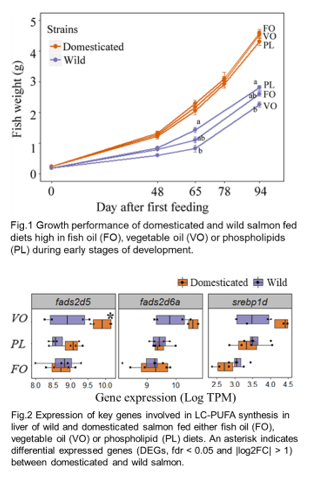COMPARATIVE TRANSCRIPTOMICS REVEALS DOMESTICATION-ASSOCIATED FEATURES OF ATLANTIC SALMON LIPID METABOLISM
Domestication of animals imposes strong targeted selection for desired traits but can also result in unintended selection due to new domestic environments. Atlantic salmon (Salmo salmar ) was domesticated in the 1970s and has subsequently been selected for faster growth in systematic breeding programmes. More recently, salmon aquaculture has replaced fish oils (FOs) with vegetable oils (VOs) in feed, radically changing the levels of essential long-chain polyunsaturated fatty acids (LC-PUFAs). The aim of our study was to study the impact of domestication on metabolism and explore the hypothesis that the shift to VO diets has unintentionally selected for a domestication-specific lipid metabolism. We conducted a 96-day feeding trial of domesticated and wild salmon fed diets based on FOs, VOs or phospholipids, and compared transcriptomes and fatty acids in tissues involved in lipid absorption (pyloric caeca) and lipid turnover and synthesis (liver). Domesticated salmon had faster growth (Fig.1) and higher gene expression in glucose and lipid metabolism compared to wild fish, possibly linked to differences in regulation of circadian rhythm pathways. Only the domesticated salmon increased expression of LC-PUFA synthesis genes when given Vos (Fig. 2). This transcriptome response difference was mirrored at the physiological level, with domesticated salmon having higher LC-PUFA levels but lower 18:3n-3 and 18:2n-6 levels. In line with this, the VO diet decreased growth rate in wild but not domesticated salmon. Our study revealed a clear impact of domestication on transcriptomic regulation linked to metabolism and suggests that unintentional selection in the domestic environment has resulted in evolution of stronger compensatory mechanisms to a diet low in LC-PUFAs.
